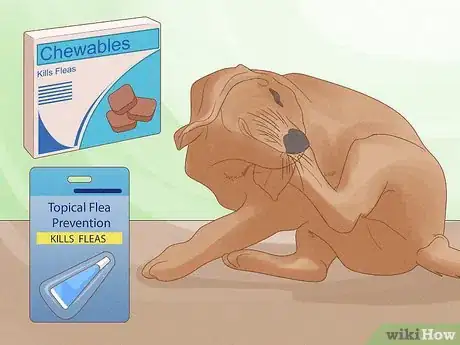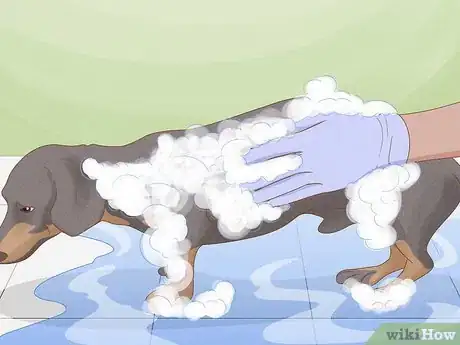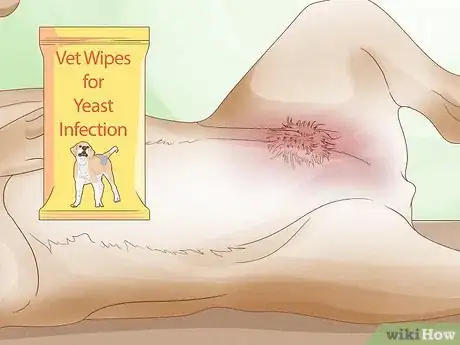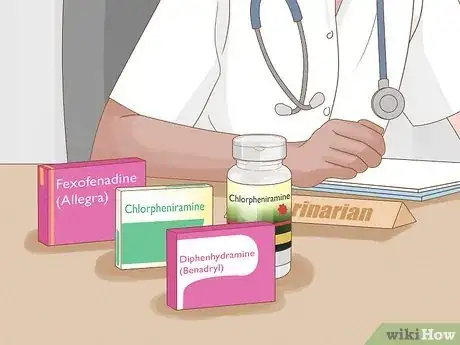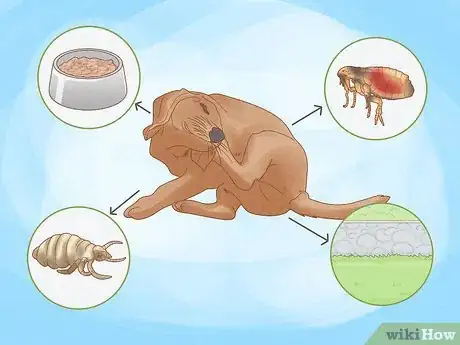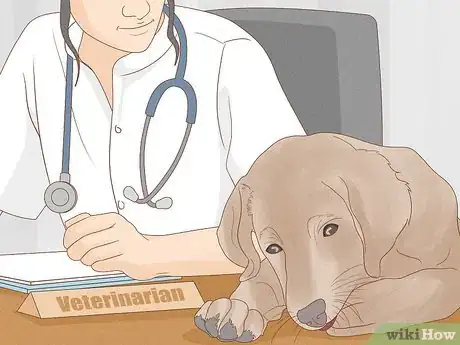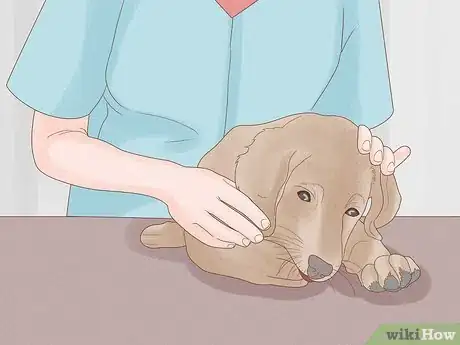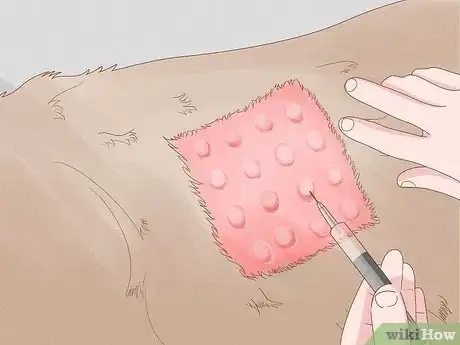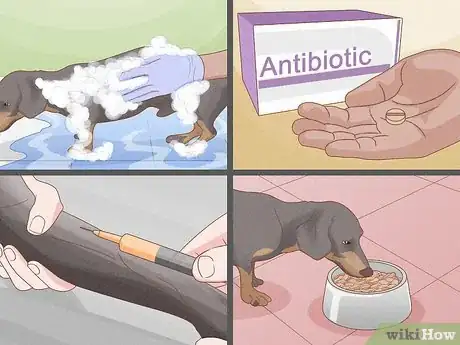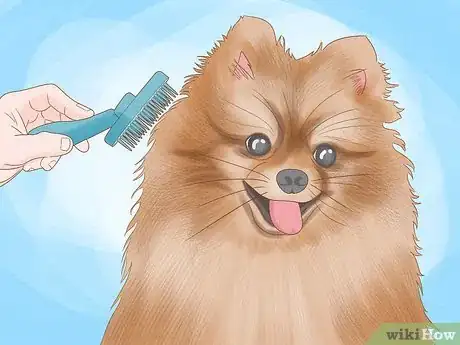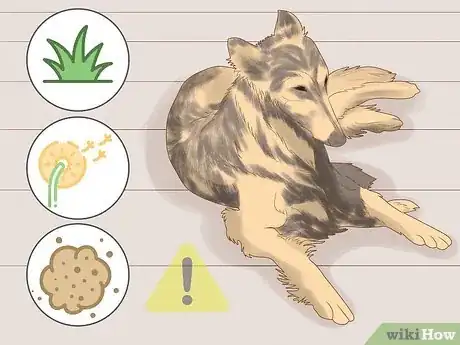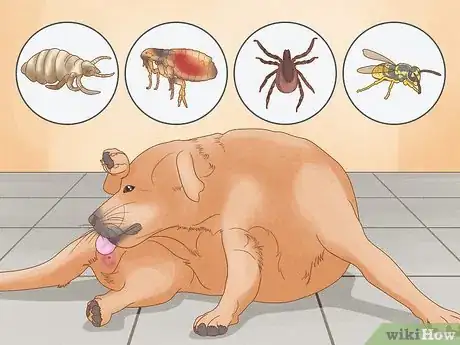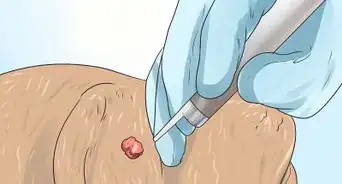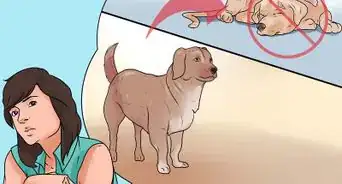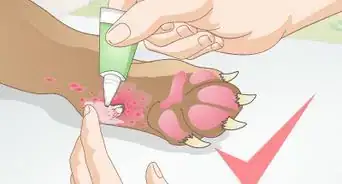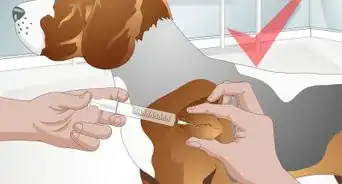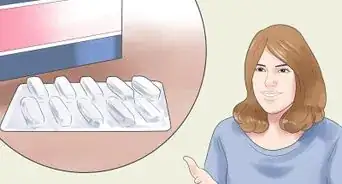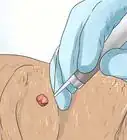This article was co-authored by Cameron Thompsen. Cameron Thompsen is a Dog Trainer and Human Coach, as well as the Owner and Founder of Hope2K9 Foundation. With nearly two decades of experience, she specializes in working with dogs and their owners on behavior issues ranging from severe anxiety, reactivity, as well as aggression and fear-based problems. She works with all dogs at Hope2K9 so that they are fully trained before adoption, and provides lifelong support to dog owners after adoption.
There are 20 references cited in this article, which can be found at the bottom of the page.
wikiHow marks an article as reader-approved once it receives enough positive feedback. In this case, several readers have written to tell us that this article was helpful to them, earning it our reader-approved status.
This article has been viewed 459,987 times.
If you've had to take your dog to the vet because of itchy skin or ears, you're not alone. These are the most common reasons for non-routine veterinary visits for dogs in the United States.[1] It may be difficult to solve your dog's scratching problems, since many health issues can cause or contribute to itching.[2] The best way to help your dog is to get professional help early on. Early treatment is typically easier and less expensive than treatment for advanced disease processes. It also spares your dog from prolonged or needless discomfort.
Steps
Preventing and Controlling Mild or New Itching
-
1Treat your dog for fleas. Fleas are the number one cause of itching in dogs, so make sure that all your pets are on year-round flea preventatives. If your pets are not on a monthly flea preventative or are almost due for their next dose, use a veterinarian-approved flea preventative that kills adult fleas on them. Treat your dog even if you have not seen any fleas. Fleas are small and easy to miss.
- Your dog may be suffering from a flea allergy even if you haven't noticed fleas.[3] Your dog may be allergic to flea saliva and severe skin disease can develop after only one or two bites.
-
2Properly bathe your dog. Bathing is effective in relieving itching in dogs with a number of skin problems. Don't worry about drying out your dog's skin with bathing. This is unlikely to happen as long as you use a mild shampoo designed for dogs — use a dog shampoo designed to work with the pH of canine skin. Look for a product that's soothing and follow with an oatmeal-based conditioner, for the most effective moisturizer.[4] Comb or brush your dog before bathing, since wet hair mats more easily. Thoroughly massage the shampoo into the dog's skin for about 10 minutes, and make sure the lather has contact with the skin.[5] Rinse thoroughly with cool water and dry the dog completely using a towel.
- Some of the benefits of bathing an itchy dog include the following:[6]
- Unclogging hair follicles by removing dirt, oil and other debris.
- Decreasing yeast and bacteria on the surface of the skin, which are frequently cause skin itching.
- Removing potential allergens from the coat.
- Moisturizing the skin.
- Improving the health of the skin.
- If you have applied a topical flea preventative or plan to apply one, read the medication's label directions with regard to bathing. Some products require that the dog has not been bathed for 24 to 48 hours before application, and most recommend waiting to bathe a dog for a specific period of time after application.
Advertisement - Some of the benefits of bathing an itchy dog include the following:[6]
-
3Treat a bacterial or yeast infection. Bacterial or yeast infections of the skin are usually diagnosed by the veterinarian. The vet will most likely prescribe topical medications that you'll need to apply. You'll also need to give antibiotics to completely treat the infection.
- Your vet will probably also prescribe medications to treat the itchiness caused by the infection. These may include corticosteroids or antifungal medications.[7]
- Look for special pet wet wipes that are designed to combat dog yeast infections. There are several available without prescription. Wipe the areas most affected by the infection (such as paws or armpits) with the wipes twice daily.
-
4Talk to your vet about using an antihistamine. You may be tempted to give an over-the-counter antihistamine to your itchy dog, but this may not be particularly effective. There are no antihistamines currently licensed for use in small animals in the United States,[8] so all use is off label. If you do want to try an antihistamine, you should check with your veterinarian first, especially if you have a dog with a chronic illness or one that is on other medications. If you do choose to give one of these drugs, make sure to give only the recommended dose and check that formulation you are using is safe for dogs. Do not use these drugs long-term or use more than one at a time without specific instructions from a veterinarian.
- In studies, antihistamines helped less than 30 percent of treated dogs with itchy skin caused by environmental allergies.[9]
- Antihistamines may or may not be less effective at treating other causes of itching. They're best used as preventatives for dogs with known allergies and in combination with other therapies.[10]
- Here are the current dose recommendations for OTC antihistamines:[11]
- Diphenhydramine (Benadryl): 1 mg/ lb twice a day.
- Chlorpheniramine in dogs less than 45 lbs: 4 mg three times per day.
- Chlorpheniramine in dogs over 45 lbs: 8 mg three times per day.
- Fexofenadine (Allegra): 1 mg/ lb once or twice a day.
-
5Follow an elimination diet to determine food allergies. If you suspect your dog is allergic to something in his diet, you need to figure out what's causing the problem. Dogs most commonly react to a protein source. Talk to your vet about switching your dog onto a limited ingredient food that does not contain the proteins your dog regularly eats. For example, if your dog eats a lot of chicken or lamb, look for a salmon- or venison-based diet. Don't expect to see results straight away, it can take several weeks for food allergens to clear the system.[12]
- Make sure you don't feed anything but the specific diet during this period of time, no treats, no table scraps.
- Take care when re-introducing food to your dog. Once you have determined what your dog is allergic to, reintroduce the food and watch for symptoms to reappear, confirming your diagnosis.[13]
Solving Severe and Chronic Itching Problems
-
1Consider any sources of severe itching. Some potential causes of itching in dogs include the following:
- Parasites, including lice, mites and fleas.
- Bacterial and yeast infections. These only occur when the skin is damaged or made vulnerable by some underlying disease or allergy.
- Food allergies.[14]
- Environmental allergies.
- Hypersensitivity to tick or insect bites.[15]
- Less common causes include autoimmune diseases, endocrine diseases, certain cancers and others.[16]
-
2Research allergies for your specific breed of dog. While any dog breed can be allergic to something, certain breeds are prone to specific types of allergies. Do your research about what allergies or health conditions may be more likely with your dog's breed. This may give you a clue about what's bothering your pet.[17]
- For example, if you have a cocker spaniel, you may learn that he is likely to get food allergies at some point in his life. You'll most likely notice itching on his ears and feet if he does have a food allergy.[18]
-
3Know when to take your dog to the vet. If you've practiced good flea control and give your dog a thorough bath, but he has been itching for more than seven days, your dog needs to see a vet.[19] You should also take him to the vet if the scratching is so severe that you cannot distract him from scratching, or it stops it from eating or sleeping.
- Itchy skin in a dog may be a symptom of any number of health problems. This means that diagnosing and treating your dog's specific problem requires a step-wise approach. This will rule out causes of itching starting with the most common and progressing to rarer potential causes.
-
4Understand what the vet will ask you. Generally, veterinarians start examining an itchy dog by getting a thorough history and doing a physical examination. To help your veterinarian get an accurate picture of your dog's condition, consider writing out a history before the visit so that you don't forget to mention any critical facts. Some important facts to share include the following:
- How long the dog has lived with you.
- Where you got the dog.
- How long the dog has been itchy and whether the problem has improved, gotten worse, remained constant or tended to wax and wane.
- Where on the body the dog seems to be itchy.
- The dog's current and past diets and any treats, table food or other food you give the pet.
- Where the dog spends its time (in the house, in the yard, roaming the woods, swimming in pools or natural bodies of water, etc.)
- Contact the dog has with other animals, including other household pets, wild animals in the yard or the woods and other dogs at the kennel, the groomer, the dog park or other places.
- Whether or not other pets or people in the household are itchy.
- Whether or not the dog has had problems with itching in the past.
- Whether or not the itching seems to be seasonal.
- The dog's medications, including flea and heartworm preventatives, prescription medications, topical ointments and shampoos, over-the-counter drugs and supplements.
- Any symptoms other than itching.
- Any steps, including bathing, supplements, diet, drugs, topical therapy, clipping and others, you have taken to try to control the itching and the dog's response to these interventions.
-
5Be prepared for further testing. The vet may recommend further tests, such as a microscopic examination of some plucked hairs, skin scrapings, ear swabs, blood tests or others to rule out the most likely causes of your dog's itching based on the pet's symptoms. These tests will help the veterinarian decide on a plan for treating your dog's skin issues.
-
6Learn common treatments. Treatment depends on the severity of the symptoms and the cause or suspected cause of the itching. Common treatments include anti-parasitic medications, regular bathing with medicated shampoos, antibiotics, oral or topical steroids, immunosuppressive drugs, dietary supplements, diet changes and others.[22]
- When dealing with an itchy dog, it is important to be patient and follow your veterinarian's plan, including giving the dog all prescribed treatments.[23] In the long-run, your dog will have the best chance of making a full recovery if you follow a careful plan and rule out causes of itching in a logical order.
Using Common Home Treatments for Skin and Scratching Problems
-
1Groom your dog. If your pet has long hair, consider having his coat clipped. Experts recommend that dogs with itching problems have hair that is less than 5 centimeters or 2 inches in length.[24] Hair can irritate itchy skin. Dogs with short hair are easier to keep clean and treat for skin disease.
-
2Care for an environmental allergy. Some dogs are allergic to grass, dust, or pollen. Once you or your veterinarian has identified what environmental condition your dog is allergic to, try to remove your dog from the problem. For example, if your dog is allergic to grass, you may want to keep him inside until the reaction clears up, and have him avoid any freshly-cut grass. When you do let him out again, put him in a t-shirt or something that comes between his skin and the grass.
- If your dog is allergic to dust, be sure to vacuum the rugs, curtains, and upholstery in your house at least twice a week using a vacuum with a HEPA filter. You should also wash your dog's bedding once a week.[25]
- If your dog has a pollen or airborne allergy, your vet might give an allergy injection. This will help build your dog's resistance to the allergen. Bathe your dog every two to three days to remove the allergens from his coat.
-
3Respond to hypersensitivity from insect bites. If your dog is allergic to flea or bug bites, you'll need to preventatively treat him from future bites. You'll need to start a flea control problem. Talk to your veterinarian about giving your dog preventative medication.[26] You may need to give your pet medication once or twice a month.
- In the meantime, try washing and grooming your dog at least once a week. Ask your vet if you should use a flea shampoo.
Expert Q&A
-
QuestionMy dog constantly scratches and bites her feet. At what point should I put a cone on her head?
 Pippa Elliott, MRCVSDr. Elliott, BVMS, MRCVS is a veterinarian with over 30 years of experience in veterinary surgery and companion animal practice. She graduated from the University of Glasgow in 1987 with a degree in veterinary medicine and surgery. She has worked at the same animal clinic in her hometown for over 20 years.
Pippa Elliott, MRCVSDr. Elliott, BVMS, MRCVS is a veterinarian with over 30 years of experience in veterinary surgery and companion animal practice. She graduated from the University of Glasgow in 1987 with a degree in veterinary medicine and surgery. She has worked at the same animal clinic in her hometown for over 20 years.
Veterinarian If she breaks the skin and makes it bleed, then a cone can prevent further damage. However, wearing a cone does not remove the itch, it just means she can't reach it. It is far preferable to identify what is making her itch and treat the underlying cause, rather than merely preventing her scratching.
If she breaks the skin and makes it bleed, then a cone can prevent further damage. However, wearing a cone does not remove the itch, it just means she can't reach it. It is far preferable to identify what is making her itch and treat the underlying cause, rather than merely preventing her scratching. -
QuestionHow do you counteract a reaction to Frontline?
 Pippa Elliott, MRCVSDr. Elliott, BVMS, MRCVS is a veterinarian with over 30 years of experience in veterinary surgery and companion animal practice. She graduated from the University of Glasgow in 1987 with a degree in veterinary medicine and surgery. She has worked at the same animal clinic in her hometown for over 20 years.
Pippa Elliott, MRCVSDr. Elliott, BVMS, MRCVS is a veterinarian with over 30 years of experience in veterinary surgery and companion animal practice. She graduated from the University of Glasgow in 1987 with a degree in veterinary medicine and surgery. She has worked at the same animal clinic in her hometown for over 20 years.
Veterinarian Some dogs develop a red sore patch and the hair falls out where the Frontline was applied. Although unpleasant, this is usually self-limiting and the hair will grow back in time. This reaction is most common with the Spot-On as it can cause rapid chilling of the hair follicles. Apply a bland medical-grade moisturizer to the sore patch and try to stop the dog scratching the area. As long as the dog doesn't scratch and further damage the skin, it should heal and settle down within a few days.
Some dogs develop a red sore patch and the hair falls out where the Frontline was applied. Although unpleasant, this is usually self-limiting and the hair will grow back in time. This reaction is most common with the Spot-On as it can cause rapid chilling of the hair follicles. Apply a bland medical-grade moisturizer to the sore patch and try to stop the dog scratching the area. As long as the dog doesn't scratch and further damage the skin, it should heal and settle down within a few days.
Warnings
- All of the treatments can result in degrees of success. But, expect flare-ups every now and again.⧼thumbs_response⧽
- When a treatment ends there is a possibility the scratching will return. The process can be repeated, however, that may not be advisable because steroid treatments are often linked to liver and kidney changes.⧼thumbs_response⧽
- Carefully read labels when buying OTC antihistamines and pay attention to both active and inactive ingredients, because many of these medications are offered combined with other drugs or flavorings that can be harmful or deadly to dogs.[30] Some common ingredients to avoid include the following:[31]
- Acetaminophen.
- Aspirin.
- Caffeine.
- Codeine.
- Dextromethorphan.
- Ephedrine.
- Hydrocodone.
- Phenylpropanolamine.
- Pseudoephedrine.
- Xylitol.
- If you are in doubt as to whether any other ingredients are safe for dogs, check with your veterinarian or a pet poison control center before administering the medication.
⧼thumbs_response⧽
References
- ↑ http://www.veterinarypracticenews.com/May-2014/Top-10-Vet-Visit-Reasons-For-Dogs-And-Cats/
- ↑ https://www.dvm360.com/view/another-chronic-itchy-dog-now-what-proceedings
- ↑ Gail Kunkle and Richard Halliwell, "Flea Allergy and Flea Control," in BSAVA Manual of Small Animal Dermatology, 2nd edition, ed. Aiden P. Foster and Carol S. Foyle (Gloucester: British Small Animal veterinary Association, 2003).
- ↑ https://www.dvm360.com/view/cvc-highlights-bathing-key-managing-pruritus-dogs-and-cats
- ↑ https://www.dvm360.com/view/cvc-highlights-bathing-key-managing-pruritus-dogs-and-cats
- ↑ https://www.dvm360.com/view/cvc-highlights-bathing-key-managing-pruritus-dogs-and-cats
- ↑ https://www.aspca.org/pet-care/dog-care/skin-problems
- ↑ Judith Joyce, Notes on Small Animal Dermatology (New York: Wiley-Blackwell: 2011).
- ↑ Anita Patel and Peter Forsythe, Small Animal Dermatology (Philadelphia: Saunders/Elsevier: 2008).
- ↑ Anita Patel and Peter Forsythe, Small Animal Dermatology (Philadelphia: Saunders/Elsevier: 2008).
- ↑ https://www.merckvetmanual.com/mvm/pharmacology/systemic_pharmacotherapeutics_of_the_integumentary_system/antihistamines_for_integumentary_disease.html
- ↑ http://www.vcahospitals.com/main/pet-health-information/article/animal-health/allergy-general-in-dogs/428
- ↑ http://www.petmd.com/dog/centers/nutrition/evr_dg_best-dog-food-for-dogs-with-food-allergies
- ↑ Cameron Thompsen. Dog Trainer. Expert Interview. 31 March 2022.
- ↑ https://www.dvm360.com/view/canine-allergic-dermatitis-pathogenesis-clinical-signs-and-diagnosis
- ↑ https://www.dvm360.com/view/differential-diagnoses-itchy-and-scratchy-proceedings
- ↑ Cameron Thompsen. Dog Trainer. Expert Interview. 31 March 2022.
- ↑ http://mycockerspaniel.com/am_cocker_health.htm
- ↑ Cameron Thompsen. Dog Trainer. Expert Interview. 31 March 2022.
- ↑ http://www.peteducation.com/article.cfm?c=2+2111&aid=504
- ↑ https://www.aspca.org/pet-care/dog-care/allergies
- ↑ https://www.dvm360.com/view/another-chronic-itchy-dog-now-what-proceedings
- ↑ Karen A. Moriello, "How to Stop Itching in Shelter and Foster Home Dogs."
- ↑ Daniel O. Morris and Robert A. Kennis, Clinical Dermatology.
- ↑ https://www.aspca.org/pet-care/dog-care/allergies
- ↑ https://www.aspca.org/pet-care/dog-care/allergies
- ↑ https://www.dvm360.com/view/cvc-highlights-bathing-key-managing-pruritus-dogs-and-cats
- ↑ https://www.dvm360.com/view/cvc-highlights-bathing-key-managing-pruritus-dogs-and-cats
- ↑ Daniel O. Morris and Robert A. Kennis, Clinical Dermatology.
- ↑ https://www.aspcapro.org/sites/default/files/f-toxbrief_1001.pdf
- ↑ https://www.aspcapro.org/sites/default/files/f-toxbrief_1001.pdf
About This Article
To solve your dog's skin and scratching problems, start by treating it for fleas if your dog has them. Next, relieve the itching by bathing it with a mild dog shampoo and follow up with an oatmeal-based conditioner to soothe inflamed skin. Bacterial or yeast infections cause skin issues, so visit your vet and, if diagnosed, administer the prescribed topical medication to treat the infection. You can also ask about corticosteroid or antifungal medications to treat the itching. For tips on identifying allergies your dog may have, read on!
